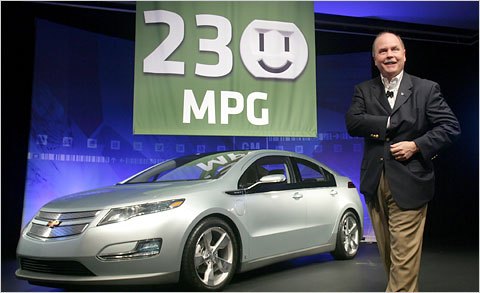Volt Birth Watch 185: EPA Still Not Buying 230 MPG Number
Production of Chevy Volt “integration models” began last week, as Hamtramck tools up for final production of GM’s wundercar, but GM still isn’t saying anything about the car’s two most important features: the pricetag and EPA rating. The General has hemmed and hawed on the Volt’s price over the last several years of hype, but it hasn’t ever been shy about touting an “expected” 230 MPG rating. Because apparently it’s the EPA’s job to clear up GM’s misleading marketing claims. So what is the deal with that 230 MPG number, anyway?
“The 230 mpg number talked about a few months ago was based on some preliminary discussion with the EPA,” said Andrew Farah, the vehicle chief engineer on the Chevrolet Volt and Opel Ampera, when asked if the number is still relevant. “Those conversations have been continuing and have not yet come to a conclusion.”
After the media conference call, Inside Line asked Rob Peterson, GM’s Volt spokesman, if the Volt’s fuel economy is still up in the air.
“I couldn’t have said it any better,” he replied.
“The discussion continues to go on between the EPA and GM,” Peterson said. “[We’re] working together to come up with a number that works best for the consumer.”
Now, try to imagine the case for the 230 MPG number being a good thing for consumers. Sure, miles-per-gallon is the standard measure, but the idea that consumers will ever be able to drive 230 miles on one gallon of gasoline is simply laughable. But the Volt project has always started with a big eco-marketing number (it started with “40 miles without burning a single drop of gasoline”) with the car being built to suit. So, will the EPA stick to its guns? One thing is for certain: if the Volt goes on sale with a 230 MPG window sticker, the Government Motors conspiracy theorists are going to have a freaking field day. Especially considering that the Volt’s rating appears to come down to “negotiations” between GM and the EPA.
UPDATE: The Detroit News paraphrases Chief Engineer Andrew Farah as saying that “road testing shows the Volt is meeting its targets, including achieving a 40-mile range on batteries alone and the goal of 50 miles per gallon when the range-extending gasoline engine kicks in.”
More by Edward Niedermeyer
Latest Car Reviews
Read moreLatest Product Reviews
Read moreRecent Comments
- Lichtronamo Watch as the non-us based automakers shift more production to Mexico in the future.
- 28-Cars-Later " Electrek recently dug around in Tesla’s online parts catalog and found that the windshield costs a whopping $1,900 to replace.To be fair, that’s around what a Mercedes S-Class or Rivian windshield costs, but the Tesla’s glass is unique because of its shape. It’s also worth noting that most insurance plans have glass replacement options that can make the repair a low- or zero-cost issue. "Now I understand why my insurance is so high despite no claims for years and about 7,500 annual miles between three cars.
- AMcA My theory is that that when the Big 3 gave away the store to the UAW in the last contract, there was a side deal in which the UAW promised to go after the non-organized transplant plants. Even the UAW understands that if the wage differential gets too high it's gonna kill the golden goose.
- MKizzy Why else does range matter? Because in the EV advocate's dream scenario of a post-ICE future, the average multi-car household will find itself with more EVs in their garages and driveways than places to plug them in or the capacity to charge then all at once without significant electrical upgrades. Unless each vehicle has enough range to allow for multiple days without plugging in, fighting over charging access in multi-EV households will be right up there with finances for causes of domestic strife.
- 28-Cars-Later WSJ blurb in Think or Swim:Workers at Volkswagen's Tennessee factory voted to join the United Auto Workers, marking a historic win for the 89- year-old union that is seeking to expand where it has struggled before, with foreign-owned factories in the South.The vote is a breakthrough for the UAW, whose membership has shrunk by about three-quarters since the 1970s, to less than 400,000 workers last year.UAW leaders have hitched their growth ambitions to organizing nonunion auto factories, many of which are in southern states where the Detroit-based labor group has failed several times and antiunion sentiment abounds."People are ready for change," said Kelcey Smith, 48, who has worked in the VW plant's paint shop for about a year, after leaving his job at an Amazon.com warehouse in town. "We look forward to making history and bringing change throughout the entire South." ...Start the clock on a Chattanooga shutdown.


































Comments
Join the conversation
It's a simple "slap in the face" to the EPA's standardized test. Every vehicle is to follow this standardized test, given by the EPA, and the final mpg number is calculated. Over the years, the EPA standardized test for mpg has been criticized by the industry for not being applicable to real-world driving. By following the standardized test, with the Volt, and legitimately reporting the number (230 mpg), it forces the EPA to finally reconsider its standardized test. Since the Volt is so new in concept, and with the Leaf (among other electrics) coming to market, the EPA has to reevaluate its testing procedure for mpg and realize that there really is no such thing as a "standardized test" for all vehicles.
To all those that think 230 mpg is too high: If I drive a Volt 30 miles a day for a year and never refill it, what is my mpg? The problem is not the number. It's the EPA thinking it needs a single number.